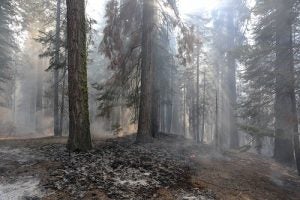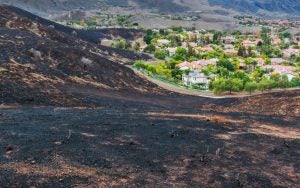Why were California’s wildfires so deadly? The answer lies in the forest
This post was updated on October 23, 2017.
 The intense fires that have ravaged my neighboring communities over the last week have been on my mind constantly.
The intense fires that have ravaged my neighboring communities over the last week have been on my mind constantly.
My heart goes out to those who have experienced great loss – loss of houses, loss of cherished items, loss of pets, and loss of life.
Many of us are left wondering, how could this happen? Could it have been prevented? How can we avoid another extreme event like this?
I don’t have all of the answers. No one does.
But we do know some things that can help us become more resilient in the face of increasingly intense and frequent fires.
What we know about the California fires
We know that in California, wildfires often occur in October after dry, hot summers. This year, we experienced record heat. When coupled with the high winds we’ve experience in recent months, small fires can quickly become monstrous and deadly.
[Tweet “Why were California’s wildfires so deadly? The answer lies in the forest, via @GrowingReturnshttps://edf.org/XUW”]
In addition to the heat and winds, California has experienced record drought in recent years. Yes, we did experience record rainfall this past winter and spring, but this summer’s extreme heat turned most of the new plant growth into dry vegetation that added fuel to the fires.
There are reports that sparking electrical wires from power lines may have instigated the large fire in Sonoma County. It’s important that we find out how these fires started, but it’s just as important that we understand how a spark can turn into a blaze that burnt more than 50,000 acres in a matter of days. We can’t prevent all fire starts and therefore we need to find ways to reduce their intensity and make communities more resilient to inevitable fires in California and throughout the West.
To help us understand that, I’ve asked my friend Gregory Giusti, a retired advisor on forest management for the University of California Cooperative Extension, to tell us a bit more about wildfires and forest management, and how we can be more resilient in the future.
“The conditions that are responsible for these fires continue to exist over thousands of acres of California’s populated landscapes.”
First, our hearts go out to the folks affected by these fires in your part of California.
Thanks, Eric. People are hurting and it will take time to heal the wounds.
Can you give us a sense of the weather and vegetation conditions that allowed these fires to turn catastrophic so quickly?
The winds were horrific that day. They literally sounded like a freight train coming at you at full speed. The winds, along with low humidity, persisted all of Sunday and into Monday. Vegetation conditions were much like the rest of California this time of year: leaf moisture conditions are low, plants are aging, further drying leaves, and fuel loads are high from years of fire suppression and lack of active tree management.
What factors led to the development of these conditions?
The driving force was wind. Other factors responsible for the devastation include:
- 100 years of fire suppression
- early and mid-20th century logging converting old growth forests to younger, more densely populated stands of trees
- suburban and rural sprawl spreading out into wildlands without adequate consideration
- programs and actions addressing fire prevention relying too heavily on fire suppression
Unfortunately, the conditions that are responsible for these fires continue to exist over thousands of acres of California’s populated landscapes.
 What are some steps that residents, homeowners and communities can take to increase fire safety?
What are some steps that residents, homeowners and communities can take to increase fire safety?
Your question can and has filled volumes of technical reports, web pages, government reports, and more on this topic. I’ll answer with a few more questions:
On a global scale how can we create a community discussion to place more emphasis on prevention and not solely on suppression? How can resources be developed to address fire prevention on private lands? What role do Resource Conservation Districts and service organizations (Rotary, Kiwanis, Soroptimists, etc.) have in securing funds to develop local programs to extend support to address fire safety?
Fire Safe Councils have a role, but they often lack funds and political support, and can’t do it alone. We need to create and maintain a community dialog that creates a “buzz” that motivates and supports all of the needed components necessary to develop fire resistant communities.
What happens after a fire? Clearly residents will need help recovering and rebuilding. But what needs to be done to ensure the recovery of all of the natural ecosystem benefits that these forests provide, like protection of watersheds, soil stabilization, recreation and more?
My experience has taught me that first people must deal with the shock and sadness of having their lives turned up-side down. Secondly, they will address insurance and clean-up needs. If, and that’s a big question for some, if folks decide to rebuild, then their focus will turn to hazard tree removal, building, and finally landscaping.
On a global scale how can we create a community discussion to place more emphasis on prevention and not solely on suppression?
Lands that were actively being managed for timber production are better positioned to address forest restoration. These landowners have contacts for foresters, loggers, heavy equipment operators – they know how to access public financial resources, and they know how to order seedlings for reforestation. Absentee owners, or elderly landowners, or those who may never have actively managed their lands, may choose to do nothing.
Landowners are not required by law to address reforestation following a fire and some may consciously choose a “no-action” alternative, while others may simply be naïve and don’t know what resources are available to them. We need to help them find the resources.
What recommendations do you have for policy makers locally and in Sacramento that might mitigate risks for future catastrophic fires throughout the state?
Local land-use policies and planners need to incorporate resiliency into developments. This could include roads large enough to accommodate modern firefighting vehicles, ingress and egress routes for times of evacuation, and establishment of early warning systems (even the old fashion method of using fire horns distributed throughout rural areas where internet service can be spotty or non-existent).
At the state or even county level, more consideration needs to be given to how current fire district funds are used and distributed. How can funds be used to put equal focus on prevention and suppression?
Right now the majority of resources are skewed to suppression, for all the right reasons, but over time, if we truly want to address reducing the risk of catastrophic fires, we have to address the vegetation conditions that allow these fires to explode under the extraordinary weather conditions we witnessed last week.
***
Greg Giusti recently retired after 32 years of service for the University of California Cooperative Extension. Greg spent his entire UC career on the north coast in Del Norte, Mendocino and Lake Counties. Since 1989, Greg’s role was as Forest and Wildlands Ecology Advisor in Lake and Mendocino Counties. His fire related experiences are drawn from his experience and work assisting the county and people of Lake County following the Valley Fire (2016) and the Clayton Fire (2016) rebuild and reforest their communities.
***
Related:
Trees are dying in California, increasing risk of fire. What can we do about it? >>
My quest to balance nature and the agricultural economy >>
The “dean of endangered species protection” on the past, present and future of America’s wildlife >>













2 Comments
After clear cutting the native forest on the mountain lopes forests were reseeded using airplanes swooping along mountainsides raining pine seed/ seedlings. The resulting forest growth was too dense bearing trees so crowded together that adequate space for vigorous, healthy growth was all but impossible. The resulting overcrowded trees were competing for inadequate light and water. Now we are eating wide swaths of growth which have succumbed to pine beetle disease, drought, and fire. We are now harvesting forests of dead and diseased trees. Let’s not repeat the past by following the same reseeding mistakes with little thought to terrain, water resources and warmer winters yielding great crops of pine beetles. It is a travesty to see the destroyed forests with little mitigation done to prevent pine beetle proliferation and resulting destruction of our national forests in the west.
When Joseph Walker and his band of fur trappers came into Yosemite in 1833-34 they describe it as being park like. Large trees and little underbrush. The native Americans had been using fire to control their environment probably for 10,000 years or more. During the California gold rush much of the timber was cut for the mines and construction of the many mining camps and towns; and probably large areas of brush were burned to make prospecting easier. But with the advent of the forest service fire suppression became the norm. This was a government program supported by most if not all “scientists”. It is hard to find dissenting views. It was simply accepted as the “truth”. Most likely anyone with a dissenting view was discouraged and not published. In the last several decades, the Forest Service has come to recognize the need and value of fires to reduce under story brush and the accumulation of dead trees, fallen limbs, etc the occurrence of which result in very hot, intense fires. Also areas of recent fires can limit the spread of new fires because burnable material has been reduced. And the flora of California is adapted to the occasional fires. This is what evolution does. It allows organisms to adapt to their environments and to changing environments.